Here is the Volume 7 of American Football from When you watch something, visit us first! Mr. Yorihisa SEKIGUCHI, former Head Coach of the “ThreeNailsCrowns “, the American Football team of J.F.Oberlin University told us about the setting up by Defense (DF) of American Football. This is the combined version of Part 7-1 and 7-2 on our YouTube channel.
In the American Football Vol.6, we learned about the Tactics of Offense and Defense of American Football.
Mr. Yorihisa SEKIGUCHI, former Head Coach of “Three Nails Crowns,” the American Football team of J. F. Oberlin University, told us again about the setting up by Defense.
.png)
Part 7-1: How to put pressure
There are always several situations where Defense (DF) definitely does not want Offense (OF) to get a 1st Down during a match. For example, if there are still long yards to go on 3rd Down, OF may choose “Shotgun” formation with many (Wide) Receivers (WR), and then, they will of course do Pass Protection.
Usually these 5 Offensive Linemen (OL) protect Quarterback (QB) and Running Back (RB) may join. On the other hand, DF, in addition to the usual 3 or 4 Pass rushers, may also have, for example, Linebacker (LB) and sometimes Safety (S) to rush, thus creating a 5- or 6-man rush and to defend Pass play by tackling QB before throwing Pass.

Otherwise, there is another idea of increasing the number of players covering the Deep zone and trying to intercept the Pass. However, it is not possible for DF to do Blitz in every play, so Stunts was born out of the need to find a way to successfully dodge OL’s block.

In Pass protection, about how these 5 OL players block these 4 DF players, there is a rule that says how block DF players among OL players. What happens if these DF players cross when each OL has a specific DF player to block?
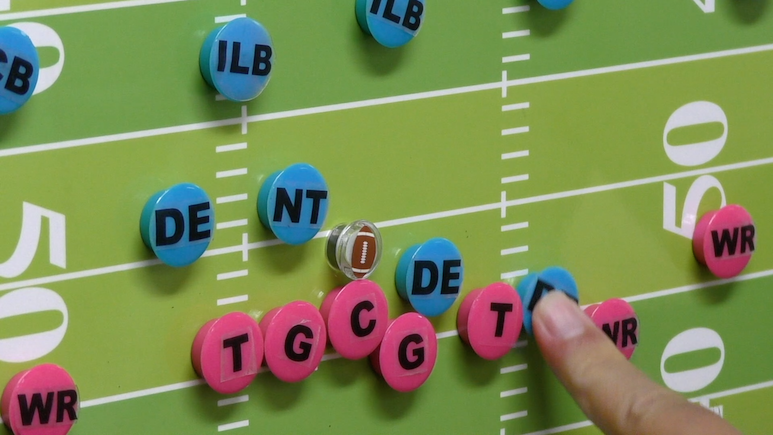
For example, if DF player to block comes inside, this player will naturally turn inside. Then, another DF player comes up behind this OL player, it is difficult to follow. This type of movement is called “Stunts,” and not only by the Defensive Line (DL) players, but sometimes LB joins to cross in this manner. While these 2 players move to this side, this DT player comes around all the way. Then this G player cannot see DT player coming.
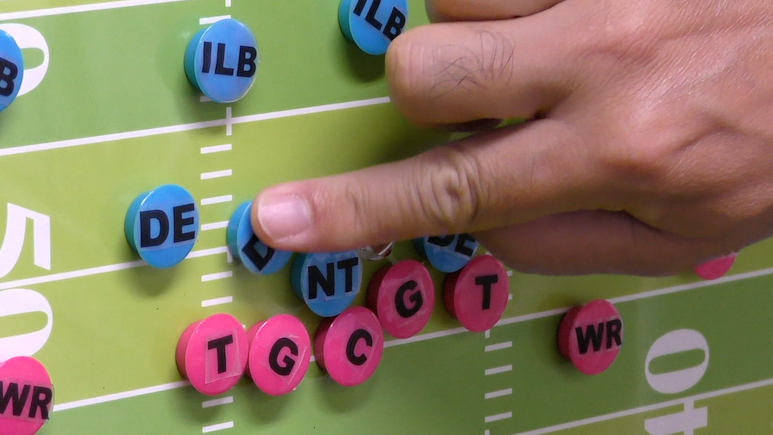
So there is a strategy to break OL protection by crossing DL players in various ways. So the way of stopping Pass will show the team’s characteristics, such as whether the team will choose Blitz, or use Stunts, or increase the players to cover Deep zone. I think it would be interesting to watch such approach of each team.
Q: How does Offense (OF) respond to Blitz?
There are at most 5 players in OF who can go out for Pass course. Well, QB can also go for the Pass course, but QB is the player who throws Pass, so that means 5 players who can go out for Pass course. If 6 DF players rush, the receivers will always be marked by man-to-man basis.
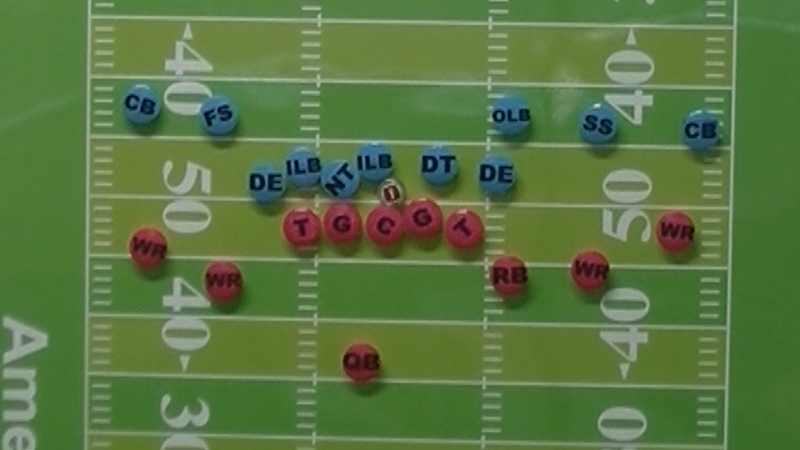
In the case of man-to-man marking, as it is difficult for DF to line-up all excellent players, so there will surely be a mismatch somewhere. For example, if this WR would definitely win a matchup between this Wide Receiver (WR) and this Cornerback (CB), this WR will be the target. This is one idea.
And, when there is a Running Back (RB) and to have this RB run this short course, for example, it may be previously decided that if this outside player (OLB) comes to Blitz, QB will automatically throw Pass to this RB. This is called a “hot receiver.”

If it is decided that QB will automatically throw Pass to RB if this OLB comes in, as none of DF will block RB, then RB will look at QB as soon as RB realizes OLB is coming in. QB will also throw Pass to RB immediately. Then, a wide space will be created around here so that RB can gain after receiving a short Pass.
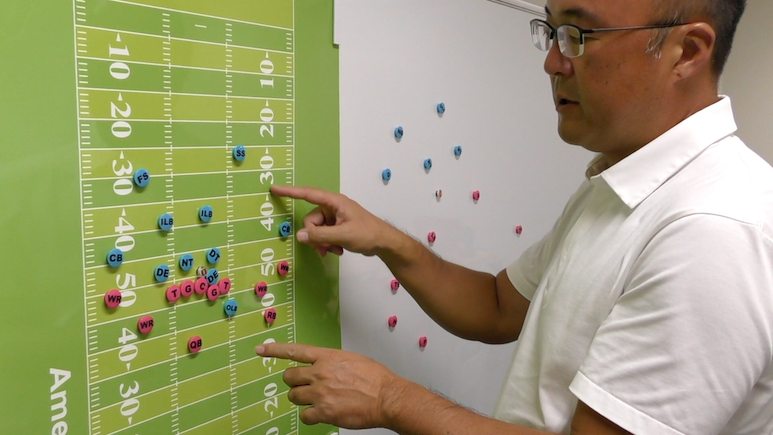
The basic way to deal with Blitz is to try to create an open Receiver and throw Pass as early as possible before Blitz reaches to QB, whether by going for a mismatch in man-to-man or by using hot receiver like this.
Q: Are there any other way to respond?
Protection may be increased in some situation. This has merits and demerits. For example, if QB knows that this OLB will obviously comes to Blitz. If OLB sets in the first row like this and QB acknowledges that DF will do Blitz, this RB was originally going for Pass course, but 1 more DF player would come in, so QB has RB stay and join the protection by 6 players.

The difficulty in this case is, however, sometimes OF has also Tight End (TE) join the protection, but since main job of TE and RB is more like playing with the ball, therefore, they are often not as good at protection as 5 players of OL, who specialize in Blocking.
So, when OLB, who is fast and ferocious, comes to Blitz, it is good if RB can protect and block properly, but if he cannot block, it is just to add useless 1 more player to the protection, therefore, OF would prefer to use hot receiver I mentioned before, to have RB go out for Pass course and pass the ball as soon as possible.
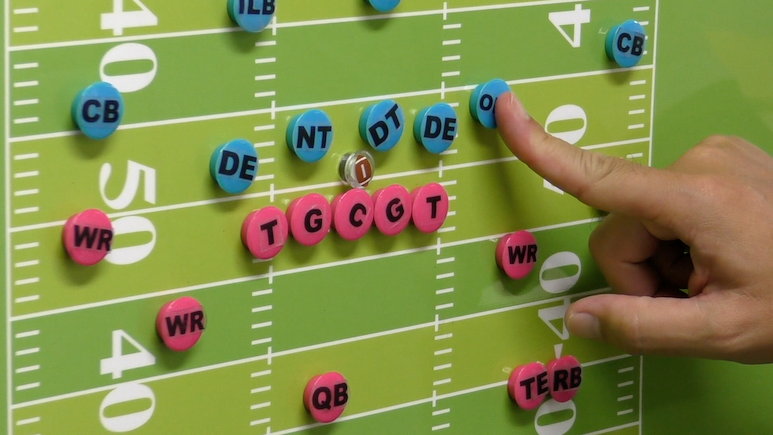
On the other hand, to make this RB block as this player is extremely good at protection is the idea of increasing the number of players of protection. Thus, how OF responds to Blitz depends on what kind of players are on the team.
Part 7-2: Timing to set up for Defense (DF)
Q: When does Defense (DF) put pressure on Offense (OF)?
Mr. (Tom) Brady (One of the best Quarterbacks in NFL history) played better when DF chose Blitz. When DF chooses Blitz, there is 1 less player to cover Pass. That makes it obviously easier QB to throw a pass. The easier Pass is thrown, the less time QB has the ball. The longer QB has the ball, the greater the risk of QB sack. So QB with good judgment will not have much trouble even if DF comes to Blitz.
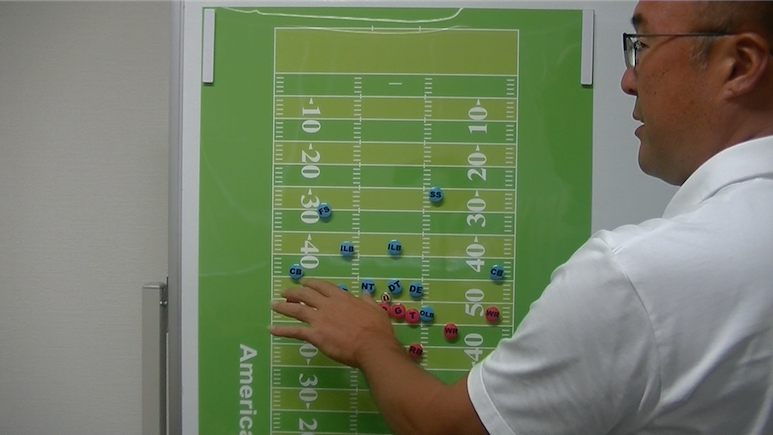
On the other hand, relating to the Brady’s story I mentioned earlier, when QB with little experience is playing, DF may come to Blitz because they want to make an interception, for example. QB who is vulnerable to Blitz will already feel a bit nervous when 5 DF players come rushing in. If the only thing on QB’s mind is to throw Pass as quickly as possible, QB will throw Pass before (Wide) Receiver (WR) reaches the point previously determined, which means that throwing errors are also likely to occur.
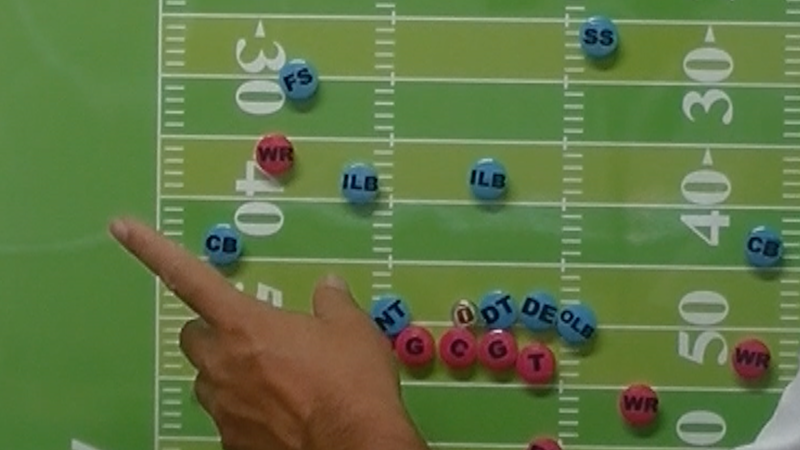
Then, when DF wants to take the ball away, they choose Blitz, and of course they aim to sack QB, but they also aim to put pressure on QB and make him throw the odd Pass. By doing so, DF can go for an interception, for example. This is a case of mixing ideas.
So DF choose Blitz when they wants to take the ball away and when they expect to change the momentum. And, from the analyze the first half trends, if DF finds that the success rate of the opponent’s QB Pass is not good when the pressure is on, DF will choose Blitz in key situations in the second half, and so on.
In the contrary, there are times that QB is not upset at all under the pressure. Sometimes, Blitz does not reach QB at all, and QB does not seem to be upset at all. There are also times that DF predetermines to choose Blitz always in some situation, so I think it is true that DF prefers to use Blitz for some reason or another.
Q: Are there any other ways to set up by DF?
Well, of course, there are times when DF pretends to go to Blitz, but they don’t. There is also the rotation of Defensive Backs (DB). For example, “Cover 2,” which I talked about a little previously. In this formation, 2 players cover Deep zone and 5 players cover Under zone.

DF pretends to be Cover 2 Defense while 5 players are in Under zone and 2 players are in Deep zone, but from this formation, these 2 CB drop back and changes to this formation. This is called “Sky Rotation”. Then DB do rotation and changes to Cover 3 formation. It looked like Cover 2 and become Cover 3.
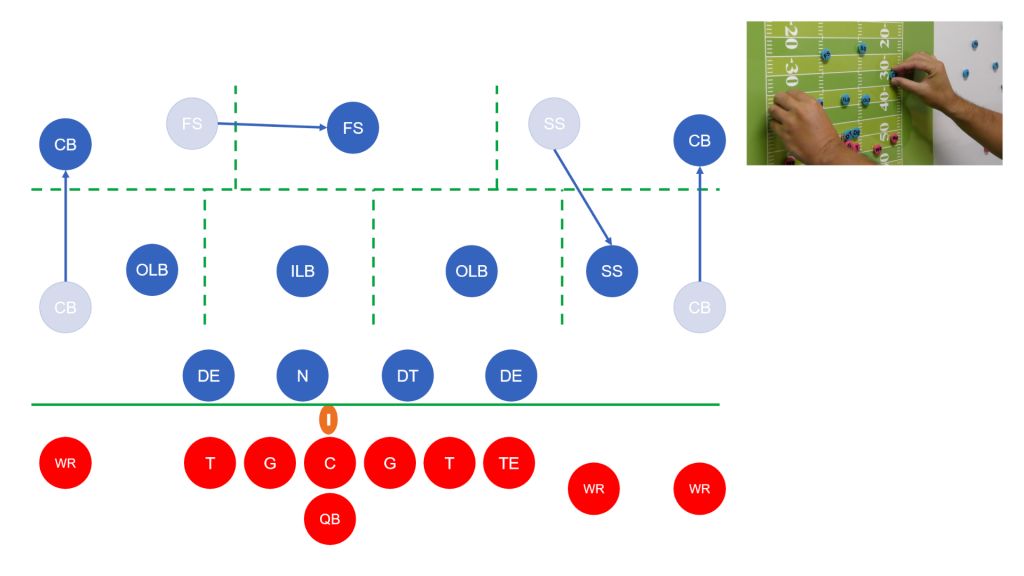
The other way is called “Cloud rotation” like this. Like this. This is “Cloud rotation.
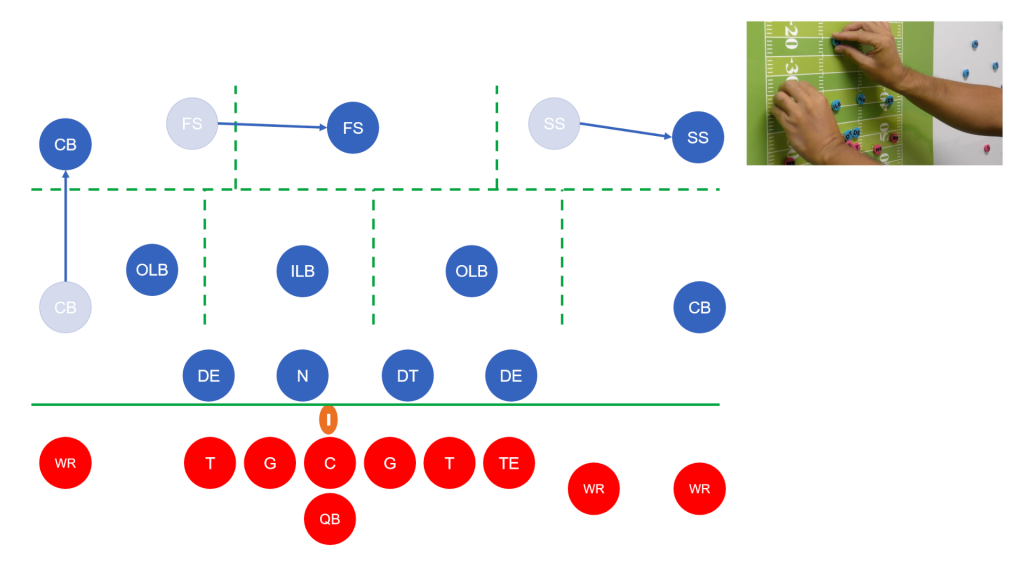
Also, as it is often seen in Japanese student matches, since there are not many QB who can throw accurately over long distances, so most QB want to throw Pass to the narrow side, that is, where the distance between WR and QB is close.
Then DF will gather the players on the narrow side. With that way, if QB cannot throw Pass to the narrow side, OF will make a mistake on the wide side on its own as QB cannot throw accurately. In Japan, it is often the case that players are rotated to a narrower side, which is called “rotation”.
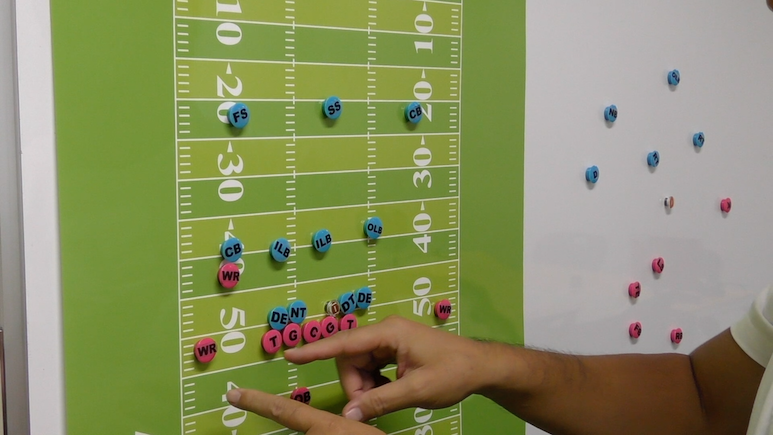
Q: The last example is a plan to make it harder to Pass for the opponent’s QB?
Yes, that’s right.
Q: What is the intention of the first 2 types of rotations?
Depending on the way of covering the field of DF, there will be strong points and weak points, so it is important for DF not to allow the opposing QB to clearly understand these strong and weak points while playing. With QB who has good control and can throw long distances, if they find which area of the coverage is weak, such QB will complete Pass one after another, so DF will change the formation in order to keep the weak areas hidden by doing this kind of rotation.
Share this content:
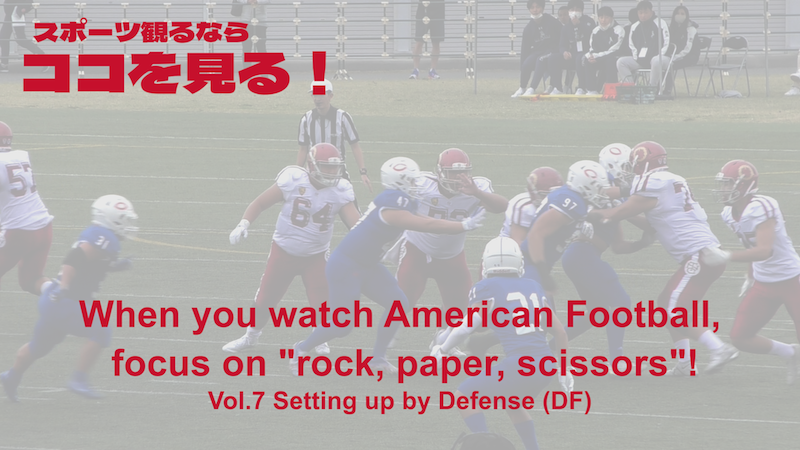
コメントを残す